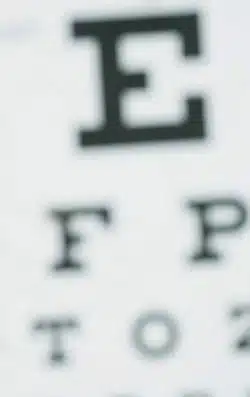You can easily read the signs that stretch down the airport corridor, but looking at your boarding pass is a blurry challenge. You rarely go anywhere without your glasses, even though you only need them to read. And you sometimes have headaches that you’re sure are due to eyestrain.
You have hyperopia, otherwise known as farsightedness. About 5-10% of the total population is farsighted, and the prevalence increases as people get older. Age-related farsightedness is called presbyopia, and it happens to nearly everyone around age 40, which is why there are large displays of reading glasses in every drugstore and supermarket. Hyperopia, on the other hand, can be diagnosed at any age. It’s a refractive error that means that the image you see up close isn’t correctly in focus when it gets sent to the retina.
Why Are You Farsighted?
 When a person looks at an object, they see light reflecting off that object to create shape, form, color, and depth. The eye takes the image created by that light and sends it toward the retina, which sits at the back of the eye. The retina then communicates through electrical impulses to the brain, which “sees” the image.
When a person looks at an object, they see light reflecting off that object to create shape, form, color, and depth. The eye takes the image created by that light and sends it toward the retina, which sits at the back of the eye. The retina then communicates through electrical impulses to the brain, which “sees” the image.
That’s how an eye that doesn’t need correction works. But in the case of farsightedness, the eye is sending the image farther than it should, to a point behind the retina. This means that the retina receives the image before it is perfectly focused, and correspondingly sends a blurry image to the brain. In the case of nearsightedness, which affects about 30% of the population, the image is focused too far in front of the retina, blurring it for a different reason.
The simplest method of correcting hyperopia is with eyeglasses. The lenses in glasses compensate for the refractive error of your eye. In other words, eyeglasses change the angle at which light hits your retina, giving clarity to the image you see. An optometrist or ophthalmologist can examine your eyes and prescribe the lenses that will correct your issues. That prescription then dictates how your lenses are manufactured.
Contact Lenses for Correcting Farsightedness
Contact lenses are small, concave plastic circles that float on the surface of your eye. Your prescription for contacts will be different from your eyeglasses prescription, primarily because the lens is on the eye rather than out in front of it. A measurement of the curvature of the cornea is crucial, for instance.
Your tears let a contact lens float on the surface of the eye, meaning your vision correction happens right as light enters the cornea. Like eyeglasses, contacts can be bifocals or trifocals; unlike eyeglasses, they can change the color of a person’s eye if so desired. There are different types of contact lenses:
- Soft lenses: Made of thin, flexible plastic that covers a larger portion of your eye, including the pupil and iris, and extends into the white. Most soft lenses are meant to be worn daily and taken out at night, but others are approved for extended wear. Soft lenses can be weighted at the bottom to keep a certain correction in the correct place.
- Rigid gas-permeable lenses (RGP): These are smaller than soft lenses, covering just the pupil and a bit of the iris. They tend to be thinner than soft lenses as well, but are rigid, meaning they hold the shape of your eye in place. The “permeable” material lets oxygen through to the cornea. They also are typically worn daily and taken out overnight, but there are extended-wear versions that allow for 7 or 30 days of wear at a time.
- Monovision: The practice of wearing one contact lens corrected for far vision in one eye and one corrected for middle or near vision in the other eye. The brain adeptly mixes the two – just as it mixes the overlapping central line of your regular vision – and sends you a single clear image.
How Laser Eye Surgery Can Correct Farsightedness
Laser surgery does what neither eyeglasses nor contact lenses can do: correct your vision by adjusting the actual shape of your eye. Millions of people have had successful laser eye surgery, which can fix several vision conditions, including farsightedness. The procedure is quick – perhaps 15-30 minutes on one eye – and done on an outpatient basis. Patients are lightly sedated but awake during the surgery, which has immediate effects.
There are different kinds of laser surgery, based on the needs of any individual patient:
- LASIK surgery: LASIK, is the most common and most well-known laser surgery procedure. Because the cornea must stay perfectly still in the correct position, a small suction ring holds it in place. A special device then cuts a hinged flap in the surface of the cornea, which is folded back. The laser is then used to sculpt the eye based on the doctor’s prescription, after which the flap of the cornea is folded back into position. No stitches are needed. Patients can usually see the difference immediately.
- PRK: Corrects the shape of the eye’s surface, but doesn’t cut a flap first. If a patient’s cornea is too thin for LASIK, PRK might be used instead. Recovery can take a little longer than with LASIK, and there is a slightly higher risk of infection and inflammation in the eye.
If you are interested in exploring new options for your farsightedness, our practice can provide information about your hyperopia and possible options to correct it.
